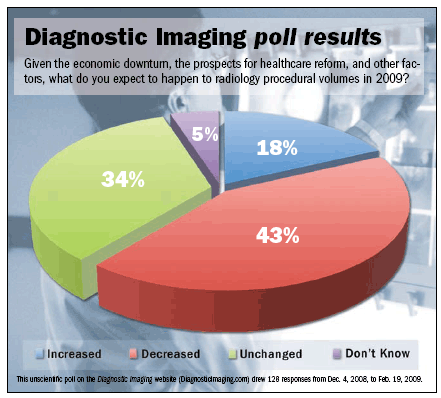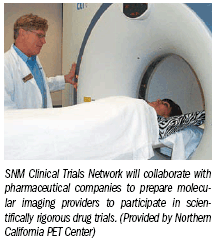Clinical trials network deals with startup growing pains
Despite progress on several fronts, the SNM Clinical Trials Network has received a cool response from recession-shocked pharmaceutical companies whose participation and financial support are considered crucial to the program's success.
Despite progress on several fronts, the SNM Clinical Trials Network has received a cool response from recession-shocked pharmaceutical companies whose participation and financial support are considered crucial to the program's success.
About 20 pharmaceutical firms were contacted about participation as of May 1. Cochair Dr. Peter Conti, director of nuclear medicine at the University of Southern California, flew to the East Coast in April for several one-on-one meetings.
Early talks coincided with the economy's slide into recession, said Dr. Robert Atcher, SNM president.
“The irony is that there is obviously recognition about the value of clinical trials, but we picked a really rotten time, in terms of the economic situation, to raise money and support,” Atcher said.
Most potential collaborators have accepted the concepts underlying the network, but as of May 1, they had not agreed to some details involved in participation. The network aims at establishing the value of imaging biomarkers of disease to streamline therapeutic drug development, according to Atcher.
Biotechnology pioneer Genentech is an early supporter. It joined the network in March, shortly before the company's $48.6 billion buyout by Roche Pharmaceuticals. The cost of network participation for Genentech is more than $100,000. Other collaborations may involve much more money.
The network needs four or five more bankable checks in similar amounts to get started. First on the to-do list is the installation of quality assurance programs at up to 40 sites for the first round of clinical trials designed and implemented by its drug company sponsors, according to Dr. David Graham, one of three network cochairs and director of nuclear medicine at the University of Iowa Carver College of Medicine. Planning for the Genentech project will move forward independently.
“This is a critical piece because we aren't going to have the finances needed to do this unless we get pharmaceutical company involvement,” he said.
The network seeks to do what imaging researchers have long said could be done with FDG-PET as a biomarker of cancer cell metabolism, said network cochair Dr. Alexander McEwan. The scientific community never gained enough experience with FDG-PET in a structured clinical trial to show with certainty that physiological measures acquired with the agent could serve as a surrogate marker of therapeutic response.

“We are increasing the chances that an appropriate biomarker application will be defined and developed at a level of appropriate quality,” McEwan said. “The fact that FDG hasn't made it is an argument for this network.”
Nuclear physicians and radiologists have touted the use of imaging bio-markers to winnow out unsuccessful therapeutic drugs candidates during early testing, thereby saving pharmaceutical companies millions of dollars. They have noted that imaging biomarkers can physiologically measure the therapeutic response of molecular agents that kill cancer cells without affecting tumor volume. But FDA regulations and the oncology community's continued reliance on anatomical measures of therapeutic response have discouraged adoption of the new methods.
The network is designed to clear away such obstacles, Graham said. It will serve as a matchmaker between the trial sponsors and prequalified clinical sites that are specifically trained and equipped by the network to participate in FDA phase I and II drug trials involving humans. The network will manage quality assurance.
The network will also support a biomarker use pathway. It is a way to fast-track access to FDA investigational new drug (IND) clearances to introduce promising molecular probes into drug trials, Atcher said.
F-18 fluorothymidine (FLT), a potential surrogate marker of cell proliferation, is first in line for this approach. Participating drug companies can link to an IND the SNM secured last year.

And the society plans to apply to the FDA for multicenter INDs for other probes, Atcher said. A hypoxia agent is a leading candidate, though the ultimate choice will depend on drug company recommendations.
One drug company official questioned whether the network is needed. In a written response to questions, he said that drug companies wishing to use FLT in their trials could avoid the cost of network involvement by using an IND for the agent held by the National Cancer Institute or by collaborating with Siemens Healthcare and its PETNET radiopharmacy subsidiary's efforts to gain FDA approval for FLT. He wrote that other candidate probes require much more development to qualify as surrogate markers.
Potential collaborators have asked the SNM representatives to come back with a better defined product, McEwan said.
Such modifications should be expected because of the program's newness and complexity, according to Graham.
“This is like forming a company with lots of committees and subcommittees. We are putting it together, and we are just getting it rolling,” he said.
For program elements that rely on physician participation, the largely volunteer effort has come together swiftly.
As of May 1, more than 200 clinical molecular imaging services equipped for PET and SPECT imaging had registered to participate as clinical trial sites since the program's inception in October 2008. Testing on a prototype tumor phantom, designed to assure consistent PET results across multiple sites, has been completed at four facilities.
GE HealthCare Debuts AI-Powered Cardiac CT Device at ACC Conference
April 1st 2025Featuring enhanced low-dose image quality with motion-free images, the Revolution Vibe CT system reportedly facilitates improved diagnostic clarity for patients with conditions ranging from in-stent restenosis to atrial fibrillation.
The Reading Room Podcast: Current Perspectives on the Updated Appropriate Use Criteria for Brain PET
March 18th 2025In a new podcast, Satoshi Minoshima, M.D., Ph.D., and James Williams, Ph.D., share their insights on the recently updated appropriate use criteria for amyloid PET and tau PET in patients with mild cognitive impairment.